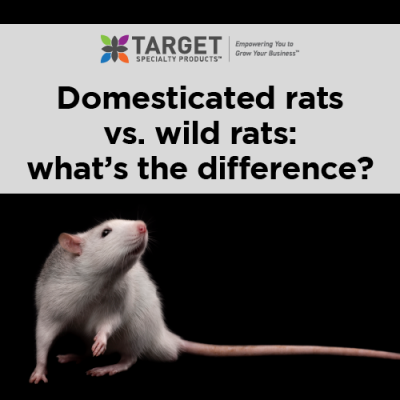
Domesticated ‘fancy rats’ vs. wild rats: What’s the difference?
Known for transmitting diseases to people and pets, and causing damage to homes, businesses and vehicles, wild rats have garnered a bit of a bad reputation. However, for owners of domesticated ‘fancy rats,’ the thought of rats being a nuisance is often a hard concept to embrace.
In recognition of World Rat Day, we have compiled some helpful information, pinpointing the key differences between wild rats and domesticated ‘fancy rats.’ By providing this information to your customers, you can help ease any apprehension by educating them on why a wild rat cannot be perceived the same as a fancy rat.
Most common rat species in North America
The two most common rats in North America, are the roof rat and the Norway rat. Although both are considered a nuisance, only one of these species has been widely domesticated and sold as a pet – the Norway rat.
Roof rat: Rattus rattus
The roof rat is also referred to as a ship rat or black rat. This species has long ears; is black with a lighter underside; and measures approximately 13 to 15 inches in length, from nose to tail.
The roof rat prefers coastal areas and tropical climates. However, they can easily adapt to colder weather, if need be. In the wild, roof rats will live off small birds, insects, vegetation, fruit, and seeds. In urban areas, they will indulge in left out pet kibble or dry goods that are easily accessible. These rats are not widely domesticated and have proven to be difficult to do so.
Norway rat: Rattus norvegicus
The Norway rat, also referred to as the brown rat, has short ears; black or brown in color with a light brown or grey underside; and measures approximately 15 to 20 inches in length, from nose to tail.
The Norway rat can be found throughout the U.S., but is more prevalent in the Northeast, Midwest, and Southwest. In the wild, its diet may consist of plants, small invertebrates, small birds, and eggs. When they have access to alternative food sources, such as dumpsters or trash cans, they will eat just about anything.
Domesticated Norway rat: Rattus norvegicus domestica
Fancy rats vary in color due to cross-breeding. Some coats are brown or black, same as their wild relatives, while others are tan, cinnamon, grey, beige or white.
Fancy rats are descendants of wild Norwegian rats. However, since having been widely domesticated in the early 20th century, they have taken on different traits and behaviors than those that live in the wild.
It should be noted that a wild rat will not exhibit the same traits as a fancy rat, and should not be kept in captivity as a pet. Although they may look similar to fancy rats, wild rats will behave differently around people.
How fancy rats differ from wild rats
Behavior
Fancy rats have a much calmer demeanor than wild rats. They are social with people, other rats, and even with other animals in their household. Like all animals that feel threatened, a fancy rat may bite to defend itself, but they are nowhere near as aggressive as their wild counterparts.
Wild rats are not social animals and prefer to avoid people, which is why they are mostly active at night. However, under certain circumstances, wild rats may relinquish their cautious behavior to scavenger for food during the day, even near people, if their survival depends on it. A scenario that has been witnessed across the country due to restaurant closures. Their survival instincts also make them aggressive and they’ve been known to attack when they feel threatened, such as when someone corners them.
Appearance
With a steady flow of food and water, fancy rats have a more robust build. And, because they’re kept in captivity, they also live longer. Living longer allows them to reach their full growth potential of 11 to 12 inches long, not including their tail.
The opposite is true for the wild rat. They tend to have a much leaner build, due to a sporadic food supply. They also have a shorter life span, preventing them from reaching their full growth potential. A wild rat maxes out at about 9 to 10 inches long, excluding their tail.
Removing rats from their environments: Why it doesn’t work
When rats are removed from their environments, either from captivity or the wild, they become stressed. For a wild rat this may mean being captured and forced to interact with humans, without having the ability to hide in a dark place. For a fancy rat, it may mean being released into the wild because its owner no longer wants to be responsible for it. In either case, the stress of this new environment will most likely shorten their lifespan.
Although a customer may feel that a wild rat in their home is harmless, because it looks the same as the one in the pet store, you can convince them otherwise. Take some time to explain the differences and why a wild rat would not make a good pet.
Target Specialty Products has been helping pest control professionals with rodent control solutions for 80 years. If you need assistance with selecting products, contact us here, we have 43 active locations across the country with representatives ready to provide their expertise and support.

